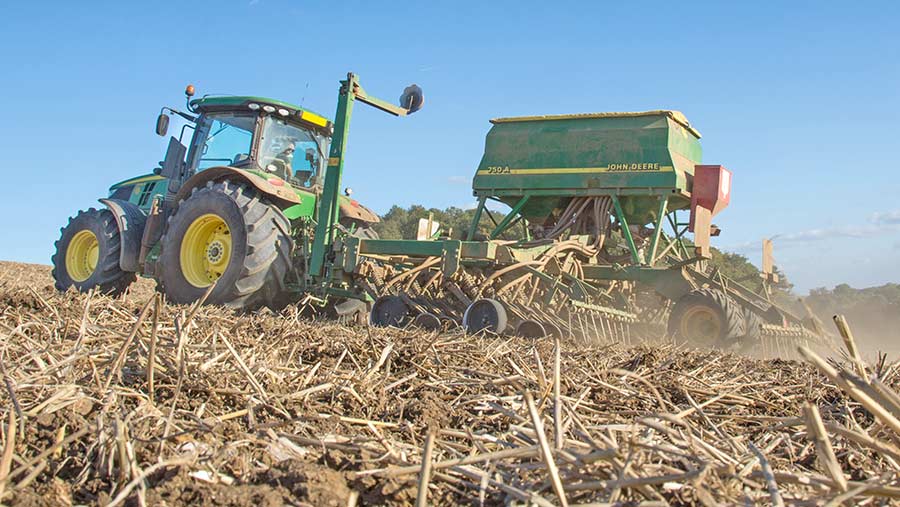Crop Watch: Weed strategies in wheat and rust alert in beet
 © Tim Scrivener
© Tim Scrivener The recent rain is welcome, with growers and agronomist hoping it will stimulate a flush of blackgrass prior to wheat drilling.
A high blackgrass dormancy year means robust residual herbicide programmes will be needed in wheat crops this autumn.
In oilseed rape, flea beetles have hammered some crops, which are at a range of growth stages. The recent rain means growers also need to be on the look-out for signs of phoma disease.
North: Mary Munro
AICC/Strutt and Parker (Perthshire)

Mary Munro
While the extraordinary political stalemate shows little sign of improving, farmers at least have plenty to get on with. Our harvest was generally good – a long-drawn-out affair, but some great yields in the end.
Sowing conditions have been pretty good, and the oilseed rape and early-sown wheat jumped out of the ground. There is a bit more than the usual insect activity at the crop-emergence stage, and some aphicides have been added to wheat weed sprays at early post-emergence.
See also: Advice on minimising the damage from BYDV in cereals
Cabbage stem flea beetle has also had some balmy sunny weather to exploit and it is not difficult to find shot-holes in OSR crops. We are still at the stages of the first true leaves coming out and growers need to keep an eye out.
My rape sprays have been based on a three-way mix of actives to get metazachlor, quinmerac, and dimethenamid-P on pre-emergence.
The cereal volunteers have been quick to come through and in most cases, the graminicides are also on.
Follow-up options may be needed too – rapeseed needs a lot of herbicide. I view this all as part of the establishment process, and if we can get swift and even emergence with good weed control, the crop is well-placed to do the rest.
Slugs can be a major threat to this process, but so far this season they have not been bad.
Wheat herbicides
Wheats are coming through and the pre-emergence options need to be considered. I like to spread the load (to avoid resistance) and where I know there are grassweed issues, a mix of Liberator (diflufenican + flufenacet) plus Picona (pendimethalin + picolinafen) or equivalent will be the foundation.
The Arylex products (containing halauxifen-methyl) look interesting and will be worth trying out in the field, as they certainly offer a wide spectrum of broad-leaved weed control.
Winter barley will also get autumn weed control, with manganese to aid winter-hardiness.
Although it is tempting to bury one’s head and carry on regardless, there are uncertain times ahead and all growers should be looking for ways to be different from the mainstream – finding a niche market or growing a wider mix of crops, and being as efficient as possible.
West: Antony Wade
Hillhampton Technical Services (Herefordshire/Shropshire)

Antony Wade
Looking back at my first autumn article this time last year, there is a remarkably similar story this season. Yes, there might be a few days’ difference in absolute timing, however, familiarity does not make it any less challenging.
Harvest, in general, was good for us, with most crops above average with only a few exceptions. However, it lingered on a little, which meant that clients didn’t really get to planting OSR until after the late August bank holiday or the first week in September.
“Ideal” was my initial thought, with rain forecast, but that didn’t materialise as significant amounts of moisture.
Crops were just germinating and then we had the “last flourish of summer”, with higher than average temperatures, which seemed to stimulate flea beetle to come from their resting phase.
Crops that looked fine on the Friday were disappearing fast by Monday, although it was difficult to find the beetles during the day, crops were alive with them in the evenings.
Spraying success
Therefore, most crops were sprayed the following week. I’m not sure how effective this was as you could still find beetles after spraying.
I took the attitude to spray them once and hope that, with rain forecast, it would stimulate growth so they would get away from this unpredictable onslaught.
It is still a bit early to assess if we have been successful, but with many pushing out two to four true leaves and rows becoming visible, I am cautiously optimistic, although slugs may become the next challenge.
Although we don’t have the grassweed pressure as in other areas that has driven later sowing, I have tried to persuade growers to drill later with the fear of a swarm of aphids in crops without Deter (clothianidin).
This hasn’t been an easy message to deliver, but unfortunately a necessary one after the loss of a seed treatment which was surely the best way to deliver well targeted early aphid control.
As a result I have only around 10% of my cereal acreage planted at present. After the recent rainfall I’m sure I am going to have further conversations about whether it was wise to hold off planting.
South: Richard Harding
Procam (Sussex)

Richard Harding
Rain has certainly stopped play, with last week seeing very little drilling being done on the Downs.
However, the rain has been more than welcome. Firstly it will encourage further grassweed germination and secondly, for any growers with oilseed rape crops sown in early September, it may have just saved the crop.
Oilseed rape crops vary greatly and are at all stages from six true leaves and out of danger to only just emerging. Cabbage stem flea beetles have been very active in the recent warm weather and most crops are now very badly shot-holed.
While some growers’ thoughts will be turning to phoma control, others haven’t spent anything on crops before feeling confident, they have a viable plant population.
Given recent dry conditions in the South East, consideration of phoma has been a relatively low priority. However, this may all change now.
The recent protracted dry weather has generally allowed good progress to be made with stale seed-beds. Now patience is required to delay drilling to allow maximum germination of blackgrass seed, in what is considered by Niab to be a high-dormancy year.
Blackgrass dormancy
ADAS studies have shown 86% of blackgrass seed could emerge within 30 days in a low-dormancy season, but only 75% of seed in a high dormancy situation.
Over longer periods, from 30-60 and 60-90 days, more of the high-dormancy seed germinated than low dormancy.
This autumn, herbicide strategies will need to be even more robust to effectively counter prolonged blackgrass seed germination and emergence. Furthermore, the role of sequential treatments is likely to be particularly effective at targeting later germinating seeds while they are still small and more effectively controlled.
Including residual activity in any peri- or post-emergence treatment will be valuable. In high-risk situations the intended strategy will be pre-emergence tri-allate followed by a pre-emergence mix of flufenacet, pendimethalin, diflufenican and prosulfocarb.
Then a post-emergence of further residual product such as flufenacet and a contact partner of iodosulfuron should be applied.
With an initial grassweed seed population of 5,000 seeds/sq m, for example, edging up control from 95% to 96% equates to 0.5m/ha fewer weeds competing in the crop. So, as always, attention to detail is vital.
In high-population situations any chemistry must be used alongside the following cultural methods:
Consider growing another crop (like spring barley); sow after mid-October; use pre- and post-drilling glyphosate even if only a few blackgrass plants have emerged; sow a robust seed rate; and opt for rotational ploughing rather than annual ploughing.
Finally, pray it stops raining…
East: Marion Self
AICC/Prime Agriculture (Suffolk)

Marion Self
Seed-beds are prepared, and drills are poised for action. Growers have held off drilling to help reduce blackgrass populations, the risk of barley yellow dwarf virus (BYDV) and disease infection.
As the drill goes “in” we set the potential for next year’s harvest and hope our patience will be rewarded. However, there is an undercurrent of anxiety regarding workload and the unsettled weather forecast.
High blackgrass dormancy and dry soils in September have limited blackgrass emergence ahead of drilling. However, recent rains should trigger emergence. Wherever possible wait for this flush and maximise seed-bed hygiene with light cultivations and glyphosate before drilling.
Considering the potential clash between time of drilling and the delayed flush of blackgrass, it is important that growers use robust pre-emergence herbicide stacks and sequences.
Pay attention to husbandry techniques that improve the activity of these treatments – for example good and consolidated seed-beds, good seed coverage (to protect the germinating seed) and good spray techniques.
Prompt application timing and moist soil conditions should enable good activity from the pre-emergence herbicides.
Aphid migration
As the first cereal crops emerge, the migration of aphid BYDV vectors is also under way. During this time be mindful to control cereal volunteers, which can host a source of aphids able to infest drilled crops.
The first pyrethroid spray to control primary infection must be applied promptly by the two-leaf stage of the crop.
Earlier emerging crops (late September/early October) will need a repeat spray to control further infection.
Rapeseed in my area falls into two categories, fabulous-looking early drilled crops and those that were drilled later and are still emerging and or pest beaten.
There are many theories as to what techniques improve establishment. I just think I’ve fathomed something significant and then another crop proves me wrong. This year early-drilled crops are winning (well, for now).
It seems that drilling in moist conditions and avoiding the main migration of cabbage stem flea beetle during emergence is the key to success. Unfortunately, this timing is most obvious in hindsight.
Where necessary, well-established rapeseed (from two true-leaf stage) can be treated with clethodim before mid-October. This would be part of a planned blackgrass strategy including propyzamide and or carbetamide.
Monitor rapeseed for peach potato aphids that transmit the turnip yellows virus and for the first signs of phoma disease, both of which are expected soon.
In some beet crops rust infection is relatively high this season. Post-Christmas-lifted beet may need a third fungicide. Always check product labels for maximum doses and observe harvest intervals.
